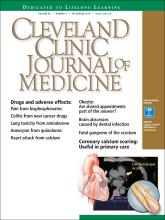ABSTRACT
Coronary artery calcium scoring is useful as a risk-stratification tool in coronary artery disease, and it outperforms other risk-assessment methods. American College of Cardiology/American Heart Association guidelines give the test a IIB recommendation in clinical scenarios in which risk stratification is uncertain. However, if the test is not used in the appropriate clinical setting, misinterpretation of the results can lead to unnecessary cardiac testing. This review provides the primary care provider with basic knowledge about the test’s clinical utility, interpretation, risks, and limitations.
- Copyright © 2018 The Cleveland Clinic Foundation. All Rights Reserved.
- Parth Parikh, MD
- Nishant Shah, MD
- Haitham Ahmed, MD, MPH
- Paul Schoenhagen, MD
- Maan Fares, MD⇑
- Department of Cardiovascular Medicine, Heart and Vascular Institute, Cleveland Clinic
- Assistant Professor, Cleveland Clinic Lerner College of Medicine of Case Western Reserve University, Cleveland, OH
- ADDRESS:
Maan Fares, MD, Department of Cardiovascular Medicine, J2-4, Cleveland Clinic, 9500 Euclid Avenue, Cleveland, OH 44195; faresm{at}ccf.org
ABSTRACT
Coronary artery calcium scoring is useful as a risk-stratification tool in coronary artery disease, and it outperforms other risk-assessment methods. American College of Cardiology/American Heart Association guidelines give the test a IIB recommendation in clinical scenarios in which risk stratification is uncertain. However, if the test is not used in the appropriate clinical setting, misinterpretation of the results can lead to unnecessary cardiac testing. This review provides the primary care provider with basic knowledge about the test’s clinical utility, interpretation, risks, and limitations.
- Copyright © 2018 The Cleveland Clinic Foundation. All Rights Reserved.






